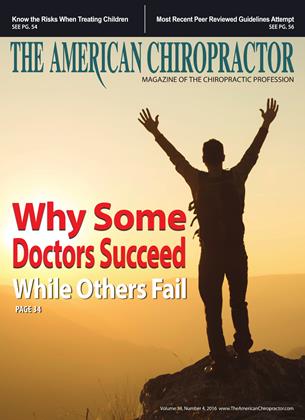The Pediatric Practice: Risk vs. Reward
FEATURE
“The potential possibilities of any child are the most intriguing and stimulating in all creation." — Ray L. Wilbur, third president of Stanford University
Stuart Hoffman
A I always had a family-oriented practice. In fact, I owned and operated chiropractic clinics for more than 24 years and, to me, nothing is more rewarding than an office filled with families. Little children running around fighting over who will hop on the table first to get adjusted and which one gets to play chiropractor while waiting for me to come into the room. Of course, Lve also had my share of bodily fluids wind up on my shirt, pants, and shoes.
Building a family practice is not that difficult, and there are plenty of programs, articles, coaches, and organizations that would be happy to help you with that. However, this is article is not about that.
This article is about putting the risk reward ratio in your favor. In other words, how to make sure you minimize the risk to the patient(s), as well as to you and your practice, while allowing the child’s innate potential to flow.
One of the advantages of being in the risk management business for as long as I have (more than 24 years) is that I have seen the best of the best and the worst of the worst. I’ve heard about miracles and I’ve heard about what went wrong, and I’m happy to say the miracles far outweigh the instances of “what went wrong.”
No one ever expects anything to go wrong, and in fact, it rarely does. The key is to make sure you follow some basic guidelines and use good judgment.
Pediatric Guidelines to Lower Risk
1. Evaluate the child properly and substantiate care through subluxation-related complaints, and then tie that back into the nervous system.
2. In your report of findings, explain about the nervous system and how important it is to function at the maximum health potential. Show the parents a chart of the nervous
In other words, how to make sure you minimize the risk to the patient(s), as well as to you and your practice, while allowing the child’s innate potential to flow. "
system and point out where their child’s subluxation is located. Then go over the child’s symptoms and explain very clearly that you are treating a vertebral subluxation, not any medical conditions.
3. Use age-appropriate health intake forms geared for children. Have one for infants up to 12 months, one for toddlers up to 16 months, and one for children up to 12 years old.
4. Use separate definitive examinations for an infant, such as 0 to 5 months, 6 to 12 months, toddler, and child.
5. Correct the vertebral subluxation and relate that back to the potential of the symptoms the child exhibits.
6. Use chiropractic diagnostic codes and musculoskeletal codes to explain to the child’s parents about the codes you’re actually using
7. Document everything. Whether it’s a cash or insurance situation, that documentation still has to happen. It doesn’t have anything to do with the age of the patient.
8. Utilize our “Informed Consent Packet” (available through ChiroSecure) and have each parent sign it. Check with your state board as to whether a separate informed consent form is necessary and at what age that would be appropriate.
9. Maintain a good professional relationship with the parents and be in agreement about the care plan.
10 . Do not overstep your boundaries and assist in the birthing process. If you do, then you are actually performing as a doula or a midwife, or a certain aspect of obstetrics, and that is where you can overreach your scope of practice. Your malpractice covers you to take care of patients chiropractically, not to deliver babies.
11. Never treat mother or baby in the hospital unless you have express written consent from the hospital giving you permission to be there. Have the parents stop by your office on the way home from the hospital for the baby’s first adjustment.
12. You need written authorization to treat a child if you know that the parents are divorced. If a single parent brings in a child, simply ask the question, “Do you think that Johnny’s father will have any issue with him receiving care here?” Again, document that answer because documentation is everything, and these conversations go a long, long way. Doctors need to understand that they must always check with their own state board to for the rules and regulations.
The rewards of a family practice are plentiful—for the child, the parents, and
you. Use good judgment and common sense, and remember to follow the twelve
guidelines to lower risk.
“When I approach a child, he inspires in me two sentiments: tenderness for what
he is and respect for what he may become. ”
— Louis Pasteur, French chemist and microbiologist
served employed Stuart over Hoffman, many associate 2 3 years DC as the Owned DCs throughout Founder and and operated his 3 CEO of 14 3 years ChiroSecure Chiropractic in practice. -Malpractice offices He and has Insurance Company. To view the live event featuring Dr. Gerry Clum visit: http://www.chirosecure.com/gerry-clum-important-studies/
 View Full Issue
View Full Issue






